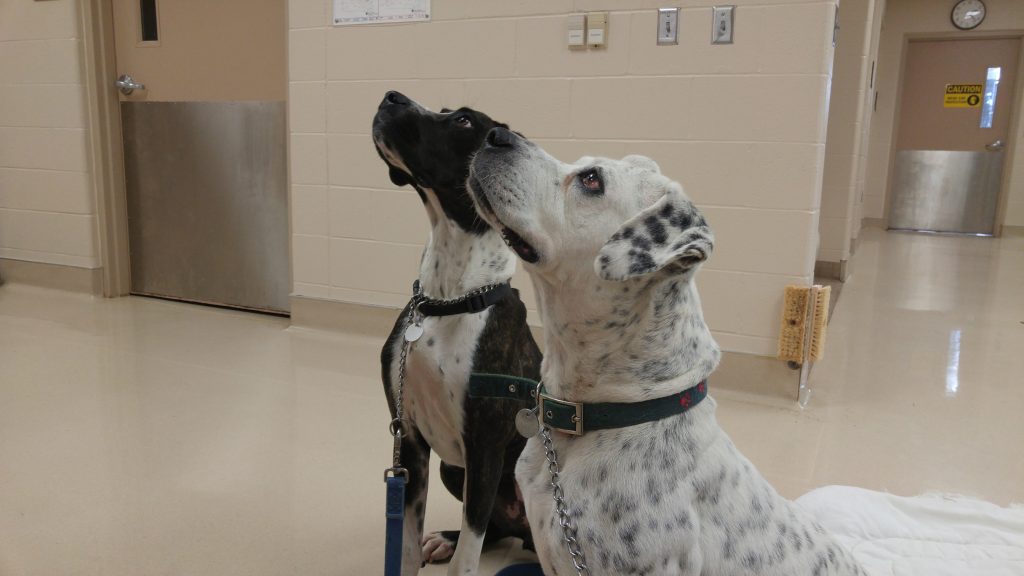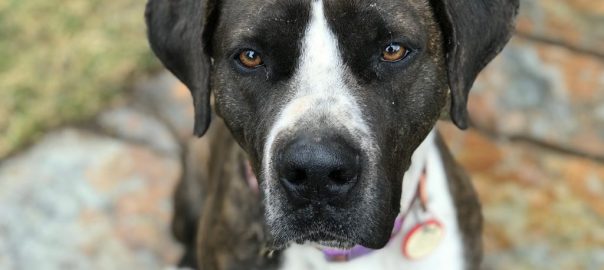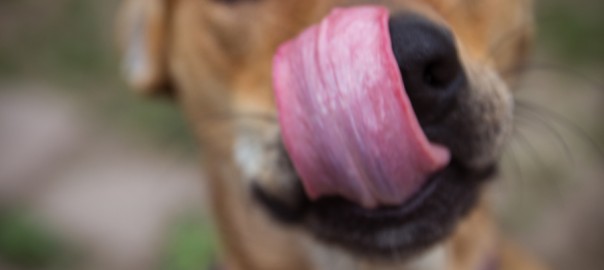Our beloved dog Quill’N, of the endlessly wagging rear end, three-legged athleticism, and pure joy of living, has gone home to her Creator. The hole in our hearts she’s left is enormous.
It was an unexpected blessing that an extremely emaciated, female, young Boxer/pit bull cross came to join the Becker family at our Almost Heaven Ranch six years ago.
I’ve shared my 68 years with 16 dogs. Big dogs, small dogs, purebred, canine-cocktail, long-haired, short-haired, guard dogs, and lard dogs. Each was special, loved without limits, pampered and appreciated, cared for and catered to. But Quill’N was something special.
I know almost certainly she never experienced the joys of being a puppy: exploring, sniffing, chewing, playing, being spoiled. Being alone, tied to a chain in the cesspool of a backyard for her first two years, ruled out all of that.
But this shell of a dog almost rose from the grave and was given a new “leash on life” when she came into a vet-tech adoption program that ultimately brought her to us. Once at Almost Heaven Ranch, we cradled her so much, she most assuredly grew bigger, not just from proper nutrition, but from an overabundance of love.
And it wasn’t just family. While she would alarm bark when anyone or anything approached our house, once they got close enough, her wildly-wagging stump of a tail was like a neon light blinking “WELCOME!” She got extra attention and treats, from UPS, FedEx, USPS, and every neighbor or visitor.
Although the whole family and all visitors loved Quill’N, it’s fair to say that I spent the most time with her, gave her the most TLC, and she loved me the most. Every time I went outside, she would signal her hello by giving out a low moan, or by the beating of her stub tail. She knew which outside visit meant a quick trip to the garage vs. a longer trip to walk the fence lines or do barn chores. Garage? I’ll stay in my bed. A jaunt? She flew out of bed, stretched, then always came over to me to find a hanging hand to touch or tussle.
How She Came to Us
In 2002, our daughter, dog trainer Mikkel Becker, was teaching a dog handling class in Kansas City, MO, for Fear Free at Fetch, a major veterinary conference. The training class was held at MCC-Maple Woods Veterinary Technician Program in Kansas City (where the Becker family has set up a scholarship fund; more on that in a minute). Mikkel was assisted by her mother, my wife,Teresa.
Before Teresa left our hotel room the morning of the dog handling class, we made a pact that she wouldn’t adopt any dogs that day. You see, we knew all the dogs in the vet-tech program came from shelters with the stipulation that they would be blessed with a forever home. We also knew that we already had too many dogs at home (four at the time). Teresa agreed. No more dogs. Direct eye contact with a “handshake” closer.
Within a few months we had two dogs from Maple Woods, bringing our ranch total to six.
How did this happen?
Teresa, who probably loves animals more than anyone else in our family, called me at the end of the day saying, “Marty…” drawing my name out for about three seconds, “There’s a dog here who I fell in love with.” Uh-oh.
The dog who touched her heart was Sterling, an eight-year-old, male dog who looked like a Dalmatian/pit bull mix. His defining feature was a large knot on the top of his head. We aren’t talking a small bump, but rather a cartoonish bump that pops up when a character is hit with a hammer. It wasn’t the age of the dog, or his bump, that touched her heart and made her break her promise; it was the fact that he was so quiet, sweet, hound-dog eyed, and the only dog in the class who hadn’t already secured a forever home.
I asked specifics about Sterling: Where did he come from? Would he get along well with our other dogs and cats? Did he chase horses or wildlife? Was he a roamer, or aggressive? What was his personality like?
The vet techs working with him told Teresa he was picked up on the street after being hit by a car and taken to an area shelter. They said he got along well with other dogs, and cats, but was somewhat distant and never played with other pets or people. And he was the opposite of aggressive – a pooch-pacifist who moved at the speed of molasses and never heard made a sound.
Predictably, my answer was, “Of course we’ll welcome him to our home, Teresa. But how will we get him here?” Sterling needed to stay in the vet-tech program until graduation, about six months off.
Along came AOGO: Adopt One, Get One.
The incredible vet techs at MCC-Maple Wood were extra loving with Sterling, trying to elicit play, giving the ol’ boy massages, and treating him with TLC. But not much changed until a young dog named E’Clair came to the tech school about three months later..
An extremely emaciated, two-year-old, female Boxer/pit bull mix, she was an adult dog who weighed under 30 pounds. E’Clair had been chained up in the yard of a rundown house in a rough section of Kansas City and was rescued by a joint operation of animal control and the police. Going to the shelter proved to be good fortune, as she was adopted into the vet tech program almost immediately.
Then something unexpected happened. Some would say miraculous. E’Clair became instant best friends with Sterling and breathed life into him.
An old beat-up male dog meets emaciated young female dog…and they fall in love. They start playing together. And guess what? Sterling starts to bark on occasion. Happy barks!

We’d check in with the veterinary nurses regularly to get updates on Sterling. Was he fully healed from being hit by the car? Yes. Had the lump gone down on his head? No.
They told us about E’Clair and how happy Sterling was. They detailed the play, talked about how Sterling and E’Clair bonded, and happily regaled us with how much happier both dogs were. They were inseparable.
Guess what? Hearing of this matchmaking miracle, we knew that we couldn’t possibly separate them. Now, how were we going to get two dogs the 1264 miles from Kansas City to our Northern Idaho home?
They say the devil is in the details; we know God was in the details here. Some dedicated, loving, vet techs, two of whom had Sterling and E’Clair as their program dogs, agreed to drive them the 704 miles from Kansas City to Rapid City, SD. Flying into Rapid City and renting a van, my son Lex and I would meet the vet techs, meet the dogs, and then drive them the 872 miles (a 13.5 hour drive) to their forever home at Almost Heaven Ranch in Idaho.
When we met in a hotel parking lot in Rapid City, the vet techs, Beckers, and Sterling and E’Clair shared a special moment. We hugged each other, laughed, mutually interacted with the doggies, and had a rather tearful goodbye. Lex drove, Sterling refusing to lie down but standing between the seats looking out the windshield, with skin-and-bones E’Clair riding in my lap in the front passenger seat. We made the trip over three days and two nights.
I can still remember the very first night in a pet-friendly hotel in eastern Montana. It was apparent the two dogs had never been on a bed before. In fact, E’Clair was terrified of going through any doorway. My best guess is that she had at some point tried to go from the chain outside into a doorway (the house) and was beaten. Other evidence for this was the fact that whenever we were sweeping with a broom or had something long and linear in our hands – Swiffer handle, yardstick, plant braces – she would either flee or collapse into a puddle of fear. Or when Teresa used the garden hose and spray wand to water her flowerpots, she would high-tail it.
Because the dogs were nervous, they had to go the bathroom a lot; so between their unfamiliarity with sleeping in the bed and busy bladders, I didn’t sleep much.
Because all of our dogs have had names starting Q for a couple of decades (Quixote, Quora, QT Pi, et al) we had pre-named Sterling, Quin’C, and E’Clair, Quill’N.
Back in the van and ready to roll, I took advantage of my extensive training in animal nutrition to serve up their first breakfast as full-blown Beckers. They ate, like we did, via McDonald’s drive thru. (I know. I know. Change of diet issues, motion sickness, I knew about some great pet foods from brands trusted and recommended by veterinarians for sensitive stomachs. Physician, heal thyself!)
We had pee-pads duct taped together covering the rental van floor and enough cleaning products to deep clean a shelter. We didn’t want the van to be the equivalent of a mobile Interstate rest stop with a doggie pit stop area. This road trip was full blown “spoil the kids” mode. We may have even stopped for ice cream. Uh, twice.
Although after a few years on the ranch Quill’N weighed a very fit 80 pounds, on her first road trip she was shockingly under 30 pounds, a rather large-framed but feather-light bundle of suppressed fear in my lap, rarely moving.
After three days of driving we arrived at Almost Heaven Ranch. All of the dogs seemed to have been in a Welcome Waggin’ mode as there wasn’t even so much as a raised hackle. Quin’C, and Quill’N were in the mixed dog pack with the resident three canine cocktails, Quixote, Quora, and Gracie.
Quill’N filled out, muscled up, and broke free of the harmful experiences of her earlier years. While she would alarm bark to let us know we had visitors, she was Walmart greeter-friendly. No matter who brought a dog with them to visit, they found a friend and playmate.
At first, Quill’N was like a free radical in a chemistry equation. Whether her wanderlust was caused by the relief of not being chained up or she wanted to test-drive her inner wolf and eat ranch-to-table at will, she proved to not be happy with just “home on our range.” She wanted to chase deer, rabbits, wild turkeys, and venture into the thousands of acres of woods that surrounded our log home, almost always bringing back souvenirs in the form of dead animals. While cats often bring their mom and dads gifts like mice and birds, Quill’N would bring us back almost-intact deer skeletons, elk horns, even a rotting skunk full of maggots. Yeah, I know. I had to get rid of all of them.
We know her travels were perilous, and we tried all sorts of ways to entice and secure her to stay closer to home. But she’d dig out, slip out, or just bolt. More than once I had to go looking for her, stopping the pickup every so far and calling out her name. Luckily, like poof, she’d appear running toward me with her tail slapping the grass or brush in happiness.
Quin’C was mostly white, and Quill’N was mostly black; visually and in reality, she was his shadow and rarely left his side after her first period of ecstatic exploration. The close communication they had developed at Maple Wood, grew into, dare I say it, love on the ranch.
Unfortunately, it was to be a short love-connection as Quin’C fell ill about six months after first calling Almost Heaven Ranch home. I took him to Washington State University College of Veterinary Medicine for an examination. With advanced diagnostics, it was determined that the persistent lump was in fact going to kill him. It was a malignant melanoma and it had spread. After a short “bucket list” adventure, we gave Quin’C the final grace.
As we almost always do now, we let Quill’N and all the other dogs be present for the euthanasia. That way they didn’t wonder what happened to Quin’C, or go looking for him. They knew he was gone.
(We set up a scholarship fund in Quin’C’s name at Maple-Wood if you’d like to donate to the program that helped us find these wonderful dogs.)
About five years later, Quill’N got a nerve sheath tumor and we had to have her left front leg amputated. As veterinarians, we joke that dogs have three legs and a spare, and after the surgery Quill’N got along really well, but her world got a lot smaller. Long gone were the days of a 150-acre playground as her orbit was about a 100-yard radius from our log home.
One last thing: No matter how hard we tried, Quill’N rarely came into the house. She had a heated, safe outdoor sleeping area and there she’d spend her nights, bounding out every morning to help with ranch chores. Being in the house made her pant and pace in nervousness, and nothing we tried made it better. She loved being an outdoor dog with the sights/sounds/smells of the woods, the chance to chase elusive chipmunks and squirrels, and to be a watchdog. We finally accepted her for who she was, and from that day on she was a happy outdoor dog, still endlessly spoiled and loved.
How Quill’N Left Us
Quill’N’s last day started like most mornings. 7 am: Open the inside lock on the back door, watch and hear (shaking awake with dog tags jingling) our big girl rise up from her fluffy orthopedic bed. At 7:30, give Quill’N her vitamins and fill her food puzzle with kibble, and add some canned food topped with her probiotic.
Next we’d sit down with our tri-paw’d dog, massage her, slap her sides and tell her that she’s been a very bad girl, then give her the empty can of dog food to lick clean.
Next we’d walk up to our horse barn with our mixed breed pack of dogs, where they’d search for “horse apples” then move into the barn stalls to lick up any sweet feed the horses had spilled from their buckets.
For the next six-seven hours she would be sleeping on her back-door bed with a few side trips to lie in the cool grass, find a sunbeam on the hard concrete driveway, pee, or “do the doo.”
On that last day, at 4 pm sharp, I left the house on my way to our tiny hometown of Bonners Ferry, ID, to get a prescription. When I exited the back door, I found our beloved girl all stretched out on her side with her single right front leg extended over the front of her bed, and her tail tapping out a tune on the back of her bed. I stopped, knelt, and told her just how bad of a girl she’d been. In response, she rolled over on her back and sunk into the bed, welcoming my tummy tickles. As I walked the short distance to our detached garage, I heard her sigh; I looked back, we locked eyes, and she smiled with her tail.
Teresa went out to water her flowers around 4:30 and watched as Quill’N walked back from the shaded grass behind our garage, stub of a tail wagging, and leaned up against Teresa, who stroked her face.
I got home at 5:30 and as I walked out of the side door of the garage and down the steps to the short walkway to the backdoor of our house, I noticed Quill’N laying on her bed in a normal position. Taking another couple of steps, I could tell Quill’N was gone. Her body was there, eyes open, still slightly warm, but she had left us for heaven.
My heart did that funny “skip-a-beat” thing that happens when you face something indescribably upsetting. I dropped my prescriptions and rushed into the house. I found Teresa in our kitchen and told her something terrible had happened. She said she read it on my face even before I spoke. Teresa asked incredulously thru tears, “What happened, Mart?” to which I replied, “I don’t know. She just died in her sleep.”
I carried my girl in my arms to our pet cemetery and, after covering her with a blanket and putting her favorite toys in with her, a neighbor brought his backhoe to fill the deep hole and level it. He put a memorial on the top of the grave, a giant letter “Q” for Quill’N.
Teresa was asking me and I was asking myself, what the heck happened to Quill’N! She was a healthy, middle-aged dog, with no known health issues. Other than having part of her small intestines removed due to a foreign body (piece of corn cob) and having her leg amputated for a benign nerve sheath tumor, she’d never been sick a single day in her life. Not one.
Veterinarians are no different than any other pet parent when a pet dies unexpectedly. First it’s WTF, but then we reflect on our education, training, and experience and run through differential diagnoses. I know the most common causes of sudden death in a middle-aged dog is in decreasing order:
- Cardiac arrest
- Undetected trauma – Such as a dog kicked by a horse, suffering a major fall, or being hit by a vehicle without obvious external injuries.
- Poisoning
Having practiced for 45 years, I’ve seen literally hundreds of cases in the practices I’ve worked in where a pet died without warning. I can honestly say, most of the time, pet moms and dads think their pet must have been poisoned. How else could their pet have possibly “just died”?
In veterinary school most animals that die are given a post mortem exam, what in human medicine we call an autopsy. That’s how we learn, by actually seeing pathology and determining a cause of death. In veterinary practice, most pet parents don’t want to put their pets through a post mortem exam. And I can see why. They want to think of their dogs just having gone to sleep.
Just like all other pet parents, neither Teresa, nor I, even considered doing a post mortem exam on Quill’N. But knowing that, according to long-term studies from veterinary school pathology departments, fewer than 5 percent of unexpected deaths are from poisoning, and with no signs of external trauma or being at risk of such, Quill’N almost certainly died from sudden, massive heart failure. Zero struggle, no evacuation of bladder or bowels, no vomiting or saliva. She just went to sleep.
Now That She’s Gone
I’ve written in intimate, deeply emotional detail about losing previous dogs. From Chicken Soup for the Pet Lover’s Soul to my newsletter, I’ve shared with you the deep grief of losing a pet – mostly the same feelings you have, but perhaps a little different, because mine comes from the perspective of a veterinary healthcare professional.
This loss is different than all others, though. With all the other dogs, I was present when they passed as all were euthanized. I felt the last heartbeat and breath. The falling of the chest, the relaxation of every muscle, the tail going still, the last light leaving the eyes.
Leading up to the euthanasia, I left nothing unsaid. Reflecting over special moments of the special affection-connection we shared. I assured them that we were only going to be apart for a little while, that we’d see each other again someday, same routines, new bodies. But this time, our house would be full, as all 16 dogs would be playing together.
With all our animal family members given the last grace, at the moment of passing there would be a lump in my throat the size of an Idaho potato. Then the dam would burst, and I’d collapse on top of their bodies cradling them as the last sparks of life left. Tears would come, unexpectedly, for days. I’d go through all five stages of grief.
I still think I see her when we come down our driveway. I’ve heard her bark at night, but know she’s not there. There is an emptiness now where she once was. It is so quiet and so still outside our backdoor where she always waited for us.
But I haven’t shed a tear for Quill’N’s loss yet. I’m thinking something is wrong with me. I know I’m not desensitized to loss. I know I loved her with all my heart. I know she’s gone as I laid her in the grave myself. What’s wrong with me? Am I stuck in the first stages of grief: Denial and isolation?
I’ll keep you updated as this loss plays out. If anyone of has experienced something similar or have any advice, please share. While I won’t be able to bathe Quill’N in my tears, I want desperately to cry over her.





